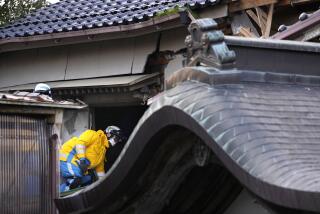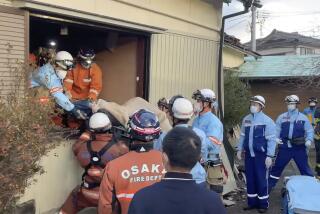New progress, worries in Japan nuclear crisis
Japan took a step toward possibly getting its nuclear disaster under control Sunday as electricity to power some reactor cooling systems was restored and previous efforts to lower reactor temperatures with seawater at the battered Fukushima atomic energy plant appeared to have had an effect.
But the increased optimism by Japanese officials and Western scientists alike was tempered by a newly emerging crisis -- radiation contamination was found in some food and water supplies in a nation already suffering from a cascade of troubles.
Although Japan’s Health Ministry said the contamination levels were not immediately harmful to humans, the discovery of higher-than-normal radioactivity in batches of milk and spinach -- and of traces of radioactive iodine in tap water in Tokyo and elsewhere -- stirred new angst in a public already weary from earthquake aftershocks, blackouts and the threat of a full-fledged nuclear meltdown.
Early Sunday, consumers at some central Tokyo markets were lining up to buy milk, which already had been in short supply after milk-carton factories were knocked out by the quake and tsunami.
“The government keeps urging people to stay calm, but there’s a sense of growing anxiety,” said Hiroaki Nakajima, an employee at the Kimuraya supermarket.
Even before news of the tainted foods, he said, people were hoarding things that they wouldn’t normally buy, like instant noodles, water and rice. Now, he said, customers ask where the milk and spinach come from.
A series of disasters have been battering Japan since a record-setting earthquake struck March 11 and a tsunami slammed into the northeastern coast. At least 8,130 people were killed, and 12,272 are unaccounted for, according to police.
The tsunami also knocked out cooling systems at the Fukushima Daiichi nuclear power plant about 150 miles north of Tokyo, causing the complex to leak radiation.
The concerns about contaminated food over the weekend arose even as more supplies reached some tsunami-stricken areas on the northeast coast and as officials of the Tokyo Electric Power Co., the operator of the Fukushima plant, indicated that connecting electrical cables had helped cool reactor Nos. 5 and 6.
The company said it was hopeful of restoring electricity to the No. 1 and 2 units as early as Sunday, but it remained to be seen whether that would restart the cooling system for those reactors, given the extent of their damage.
“I don’t think it is a sure thing at all. All the reactors were exposed to shock, so who knows if the piping is still intact?” said Edwin Lyman of the Union of Concerned Scientists in Washington.
Lyman and other experts nonetheless took the restoration of power as an optimistic sign. It “is absolutely a turning point” in the battle to cool the reactors, USC nuclear physicist Najmedin Meshkati said.
In one potentially hopeful development, officials said they planned to test high voltage power lines as early as Sunday afternoon that would restore operations to cooling equipment at damaged reactors Nos. 1 and 2.
Experts were not surprised that inspectors found contaminated food. After the Chernobyl nuclear power plant disaster in 1986, a major cause of the thyroid disease suffered by children came from consumption of tainted foods, said Dr. Glenn D. Braunstein, chairman of the department of medicine at Cedars-Sinai Medical Center in Los Angeles.
Japanese health officials have dismissed such fears, saying that the amount of radiation detected away from the Fukushima plant is minor. Even so, traces of radiation in the food supply are a matter of concern.
The amount of radiation found in the milk, if consumed for a year, is equivalent to levels found in one CT scan. The spinach contamination is equal to one-fifth the radioactivity in a CT scan. And those levels could be harmful to children, Braunstein said.
“Children are growing and their organs are growing, so they’re very susceptible to radiation effects,” he said. “They really need to discard the milk from around the reactor disaster.”
Dr. Daniel Zurosky, director of radiation safety at the University of South Carolina School of Medicine, said contamination could also turn up in fish -- a staple of the Japanese diet -- from radioactive material that has entered the water, become part of the food chain and is consumed by fish.
He said it would be vital for Japanese health authorities to monitor food. After Chernobyl, “they weren’t very forthcoming about radiation. They had a lot of farmland around there.”
Yet there is widespread public perception that Japan hasn’t issued timely and complete information since the outbreak of the nuclear disaster. And the news of food contamination brought a flood of new complaints and worries.
“The biggest problem is that we’re not getting the whole picture from the government, from the media,” said Takamasa Edogawa, 76, standing with his hands thrust into his jacket pockets, the first in a line of about 40 people waiting to get into Tokyo supermarket Yoshiya on Sunday. “We generally know where the spinach and milk were from. But we don’t know exactly where. And if the wind changes, other areas could be affected by radiation.”
Similar feelings of helplessness were echoed in Japan’s northeast coast.
In Miyako, Souichiro Tachibana, a teacher who watched his house burn down after the tsunami hit his town, said officials haven’t offered a lot of options. “Nowhere is safe,” he said. “Teach me what I can do. I’m listening. Where can we run away to?”
Yet at the gymnasium of the Miyako Elementary School, the last day or two has seen things go from famine to feast as more supplies have arrived. “Please take some food,” volunteer Kiyohiko Sasaki said to visitors.
“We’ve been here eight days,” said Rikuko Tachibana, 61, sitting on blankets provided by the city, amid neat piles of clothing and belongings on the floor and evacuees sitting about, bored.
“At the beginning, there wasn’t enough food, and it was always rice balls,” Tachibana said. “Now there’s too much food. And it’s got more variety. We had cream soup today, boiled eggs, soba noodles, strawberry jam. And I have some fruit bread here.”
A local company has donated thick tatami mats for the evacuees to sit and sleep on, lending a little civility to the basketball courts. Evacuees carefully remove their slippers before stepping on the woven grass mats.
Shoichi Nakamura, 58, an evacuee sleeping in the Miyako Elementary School, said she stayed in the shelter because there’s no heat or power at home, and she feels more secure with other people nearby during aftershocks, such as the magnitude 5.7 temblor that struck off the coast of Fukushima prefecture just after 10 a.m. Sunday.
Rikuko Tachibana said she knew about the problems at the Fukushima nuclear complex but often preferred to talk and gossip rather than watch the news. “All I can say is, we’re cheering the nuclear workers on,” she said. “I want them to please do their best. And foreign governments and experts, please, please help us.”
mark.magnier@latimes.com
don.lee@latimes.com
Magnier reported from Miyako and Lee and special correspondent Hall reported from Tokyo. Times staff writers Thomas H. Maugh II and Shari Roan in Los Angeles contributed to this report.
More to Read
Start your day right
Sign up for Essential California for news, features and recommendations from the L.A. Times and beyond in your inbox six days a week.
You may occasionally receive promotional content from the Los Angeles Times.







